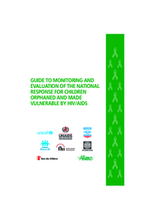WHAT: Guidance on establishing a national monitoring and evaluation process to track a country’s response to children orphaned and made vulnerable by HIV and AIDS. It includes methods and tools for measurement, and recommends a set of core indicators to record national status and changes in well-being of children affected by HIV and AIDS.
WHO: Policy makers, governments, international organizations, social and community workers and advocates involved in planning, implementing, monitoring and evaluating national progress toward the care and protection of children orphaned and made vulnerable by HIV and AIDS.
WHERE: Global relevance.
WHY: The guide recommends a set of 10 core indicators relating to key preventative interventions such as strengthening the capacity of families to protect and care for children, mobilizing and strengthening community based responses, and ensuring access to essential services. It also advises on the collection of key information relating to the child’s living arrangements and child care. This guide is useful as a management tool for planning and implementing a national response, as an accountability tool for performance monitoring, and as an advocacy tool for drawing attention to areas in need.
The guide recommends a set of 10 core indicators relating to key preventative interventions such as strengthening the capacity of families to protect and care for children, mobilizing and strengthening community based responses, and ensuring access to essential services. It also advises on the collection of key information relating to the child’s living arrangements and child care. This guide is useful as a management tool for planning and implementing a national response, as an accountability tool for performance monitoring, and as an advocacy tool for drawing attention to areas in need.
N.B. As these indicators are continuously being refined, updates on data-collection instruments and suggestions for adjustment can be found at the UNAIDS website: www.unaids.org

